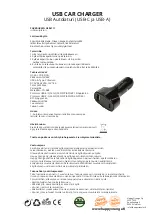
17
NOTE: Inspect all components, including the
replacement trailer ABS module, for any external
damage, such as cracked valve ports, electronic
housings, etc. Any components found to be damaged
should not be installed on the vehicle and must be
replaced.
1. Position and secure the unit in the original mounting
orientation (the exhaust port must point straight down):
For tank-mount modules:
Install the nipple fitting into
the modulator-valve supply port. Then rotate the entire
assembly into the tank port until secure. Over-torquing
of the tank nipple could cause damage to the valve
body.
For frame-mount modules:
Torque the mounting nuts
to 180-220 in-lbs.
2. Reconnect all air hoses and plugs to the module.
Depending on the installation, additional plugs may be
necessary. Make certain that no thread sealing material
enters the valve. All air hoses and fittings should be
checked for leaks prior to returning the vehicle to
service.
3. Reconnect the Electronic Control Unit (ECU) and wheel
speed sensor electrical connectors to the unit. Apply a
moderate amount of non-conductive electrical grease
to each connector pin before reconnecting.
4. The new Bendix
®
TABS-6
™
module may need to
be reconfigured for proper operation.
See Auto-
Configuration, on page 8.
5. Leakage and Operational Tests must be performed
before returning the vehicle to service.
LEAKAGE AND OPERATIONAL TESTS
For all NPT fittings use of a thread sealant is
required. For NPTF fittings the use of a thread
sealant is recommended, this can be a pre-applied
or a hand-applied sealant product (with PTFE).
When using a hand applied sealant, use caution
so as not to over-apply. Always follow the fitting
manufacturer’s pre-applied or hand-applied thread
sealant recommendations. Use of PTFE tape is not
approved and will void the Bendix ABS/TRSP valve
warranty.
1. Before performing leak tests, block the wheels.
2. Fully charge the air brake system and verify proper
brake adjustment.
3. Make several trailer brake applications and check for
prompt application and release at each wheel.
4. Check the module, modulator valve(s) and all air hose
fittings for leakage using a soap solution:
Check the ABS solenoid body with the trailer service
brakes fully applied. If leakage is excessive, more than
a one (1) inch bubble within one (1) minute, replace the
module.
Check the relay exhaust port with the trailer service
brakes released to be sure that leakage is less than a
single 1" bubble within three (3) seconds. If excessive
leakage is detected at the relay exhaust port, perform
the following test before replacing the module:
• Apply the trailer spring brakes. Recheck for leakage
around the relay exhaust port. If the exhaust port
stops leaking, this indicates a leak between the
emergency and service sides of the spring brake
chamber. However, if the relay exhaust port
continues to leak excessively, replace the Bendix
TABS-6 module.
5. Apply power and monitor the power-up sequence to
verify proper system operation.
See page 7
.
6. Determine the current ABS configuration by activating
blink code diagnostics or using a diagnostic tool. If
necessary, reset the ABS configuration and allow the
module to auto-configure.
See page 8
.
7. Calibrate and set odometer parameters if necessary
using a diagnostic tool.
Refer to the Odometer Function
section on page 8.
8. Where a safe location (e.g. restricted access area or
test track) is available, it is possible to road test the ABS
function by making an abrupt stop from a vehicle speed
of about 20 MPH to check for proper function. The
wheels should not enter a prolonged lock condition and
ABS function should be audible. It is the responsibility
of the technician to perform this test in a safe location.
Summary of Contents for TABS-6 TRAILER ABS MODULE
Page 34: ...34 NOTES...
Page 35: ...35 NOTES...
















































